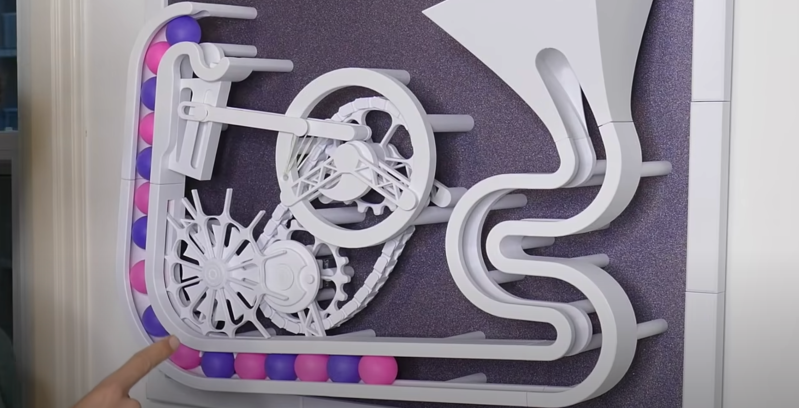In the waiting rooms of some dentists or doctors, you might have seen a giant metal ball rolling around in a large glass case. While it sure beats looking through those magazines, the sculpture can’t have come cheap. But not all of us want to pay high-end prices for fun toys. As a more cost-effective alternative, [JBV Creative] built an awesome 3D-printed ping pong sculpture.
The basic concept is the same as those fancy sculptures: a ball goes up, moves through some sort of impressive range of motion as it makes its way back down, and some sort of drive mechanism pushes it back to repeat the cycle anew. The design of this particular art piece is no different. A ping-pong ball falls down a funnel into a queue where balls are slowly loaded via a 12-way Geneva mechanism. An Archimedes spiral cam charges an elastic band that yeets the ball up and out of the track and sends it sailing through the air and down inside the funnel mentioned earlier. Everything on this sculpture is 3D-printed aside from the rubber bands and the ping pong balls.
What’s tricky about these sorts of things is the precision required both in printing and in design. It needs to run for hundreds if not thousands of hours and make no mistake. Making something work correctly 99% of the time is hard, but that last 1% can be almost as much work as that first 99%. [JBV Creative]’s first attempt had a catapult mechanism and he printed and tried out several scoops, but none gave the trajectory that he was looking for.
[JBV Creative] tried a plunger mechanism, but without a counterbalance weight providing the power, it just didn’t have enough oomph to launch the ball. Luckily, holes were included in the design, so it was relatively easy to adapt what had already been printed to use rubber bands instead. An additional goal was to have no visible fasteners, so everything needed to be mounted from the back. Check it out in action after the break.
It’s an incredible project that took serious thought, dedication, and in [JBV Creative]’s words, plenty of CAD twirling. It’s a great lesson in iterating and experimentation. If your talents are more soldering-based rather than CAD-based, perhaps a circuit sculpture is more up your alley?
















I can see the ping, but not the pong. This is a ping-ping sculpture.
Solution is to print a second model that’s horizontally mirrored, mount it next to the first, then adjust both mechanisms to launch the ball at the other mechanism’s funnel.
This guy ping pongs!
I’d say once you’re at 90%, the next 9% is probably half as much again. To get from 99 to 99.9% is often double the effort? And each successive 9 is probably harder still.
It’s like speed with a motorbike. To have a motorbike run some 280 km/h (174 mph) takes about 120 bhp. Then, to get that 20 km/h extra to pass the 300 km/h (187 mph), you need about half as much bhp extra: 180 bhp. Etc.
I’m quit sure that this is a law of nature, but have no clue. One of Finagle’s laws?
Because air resistance is proportionally squared to speed.
Yes. :) But there seems to be a higher-order law that says that anything that looks easy becomes proportionally squared harder the more you want to capitalise on it. ;)
Same for the kinetic energy being proportional the square of the speed, which means the faster an object goes, the more energy is required to make it go slightly faster, even in vaccum
And since power is force times speed, it goes up with speed cubed. Same is true in wind turbines, the available power from a given size machine is proportional to wind speed cubed.
I think Power Law is likely the best fitting, if generic, term
https://en.wikipedia.org/wiki/Power_law
I want this..it would run forever as long as it doesn’t miss. i want to create a basketball version lol.
Anyways, good idea.
The author apparently goes to much fancier doctors and dentists than I…